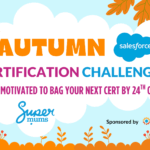How to Clean Data as a Salesforce Administrator
By Heather Black

Cleaning up data in Salesforce is like decluttering your house – it’s a big job, but once it’s done, everything runs more smoothly.
In our new book, “Become a Super Salesforce Administrator”, we talk about the four key roles every admin plays: the Problem Solver, the Innovator, the Data Champion, and the Change Agent.
These roles can help you structure your workload and focus on what really matters.
Let’s dive into some practical steps to clean up your data so it’s squeaky clean!
Join our VIP Book Waiting List and download a FREE ACTION PLAN which summarises the 4 roles and 25 tasks of a Salesforce Admin including a Data and Security Strategy.

1. Understand Your Business Data Requirements
Before you start cleaning, you need to know what’s essential. Here’s how:
- Talk to Stakeholders: What data do they use most often? What’s critical for reporting and targeting for communications?
- Define Key Metrics: Identify the data points that align with your business goals and KPIs.
- Document Requirements: Create a clear list of what “must-have” data looks like. This becomes your blueprint.
2. Evaluate Your Data Quality
Once you know what you need, it’s time to assess what you’ve got. Ask yourself:
- Is It Accurate? Check for duplicates, outdated records, and missing information.
- Is It Relevant? Identify data that no longer serves a purpose.
- Is It Consistent? Make sure data formats and naming conventions are standardised.
Use Salesforce’s built-in tools like reports and dashboards to spot trouble areas quickly.
3. Clean Up Your Data
Now comes the fun part – rolling up your sleeves and getting to work. Here’s how to do it:
- Deduplicate: Use Salesforce’s deduplication tools or third-party apps like Validity to merge duplicate records.
- Archive or Delete: Remove old, irrelevant, or incomplete records that clutter your system.
- Standardise: Update naming conventions and formats so everything is consistent.
Take it one step at a time, focusing on high-priority areas first.
4. Focus on Trusted Reporting
Once your data is clean, you can finally trust it to tell the right story. Here’s how to leverage it:
- Build Dashboards: Create reports and dashboards that highlight performance against your Data Integrity KPIs.
- Share Insights: Use your clean data to provide actionable insights to stakeholders.
- Monitor Quality: Set up ongoing data audits to keep things tidy.
When your data is clean and reliable, you’ll spend less time fixing problems and more time delivering value.
Final Thoughts
Prioritisation and data cleanliness go hand in hand. Whether you’re managing tasks or tidying up Salesforce, the key is to stay focused on what matters most. By following these steps, you’ll not only keep your system running smoothly but also provide real value to your organisation.
The four roles from “Become a Super Salesforce Administrator” can guide you in managing both tasks and data effectively. It does a deep dive into data governance and data management. Order your copy of the book today. After all, a clean and well-prioritised Salesforce org is a powerful tool for any business!
To get you started download our FREE Salesforce Data and Security Action Plan and Data Protection Training Course.
Written By:
Subscribe To Our Weekly Top Tip Bulletin
Get Updates And Learn From The Best












